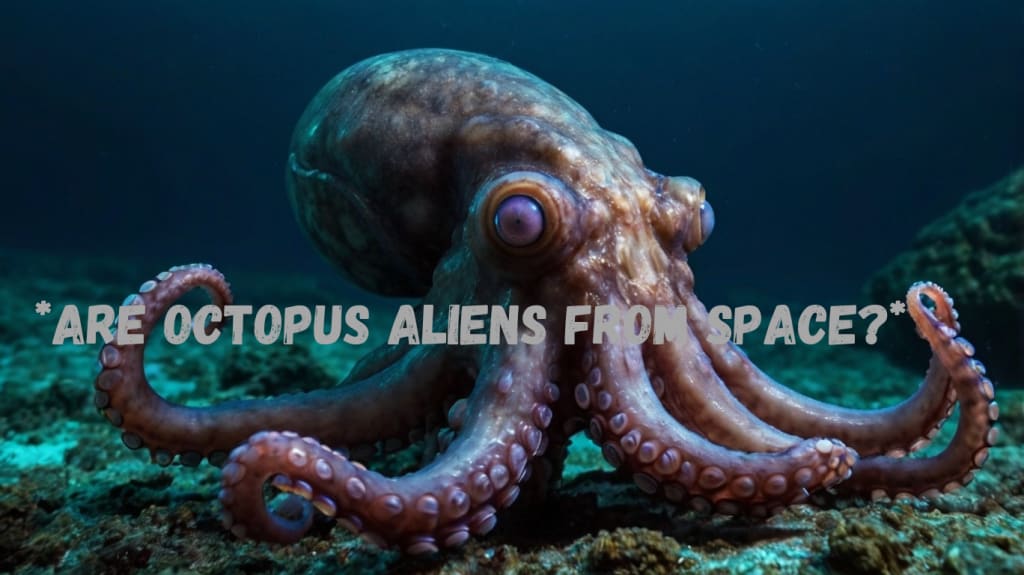From Octopuses to Bees: Unveiling Nature's Astonishing Secrets"
"Hidden Wonders: Decoding Nature's Enigmatic Secrets"

Introduction: Octopuses: Are They Alien Visitors?
Imagine a world where octopuses are not just fascinating sea creatures but potential extraterrestrial beings, visitors from outer space. This intriguing concept stems from the ancient Greek theory of panspermia, proposing that life exists throughout the universe, not limited to planets alone. According to this hypothesis, celestial bodies like ice-encased octopus eggs could have collided with Earth, blending their genetic material with the existing life forms here, giving rise to these intelligent cephalopods. While this notion might seem far-fetched, exploring the mysteries of octopuses unveils a realm of astonishing biological wonders that expand our understanding of life on Earth.
The Ancient Origins and Remarkable Capabilities of Octopuses
Octopuses, with their enigmatic intelligence, trace back millions of years, predating even dinosaurs. Fossil evidence indicates their existence nearly 300 million years ago, highlighting their enduring lineage in Earth's evolutionary history. What sets octopuses apart is not just their ancient origins but also their incredible adaptability and problem-solving abilities. Unlike most animals where the majority of neurons reside in the brain, octopuses allocate two-thirds of their neurons to their arms, granting them remarkable dexterity and autonomy. This allows them to multitask effectively, showcasing a level of intelligence akin to ninja-like prowess in the animal kingdom.
Expanding Perspectives on Animal Intelligence: Pigs, Pigeons, and Kangaroos
While humans often claim the title of the most intelligent species, recent studies have shed light on the cognitive abilities of other creatures. Pigs, for instance, surprised researchers by excelling in joystick-based video games, showcasing their cognitive agility and adaptability. Similarly, pigeons demonstrated an aptitude for art recognition, challenging traditional notions of animal perception and learning. Even kangaroos, particularly the red kangaroo, defy conventional locomotion norms by utilizing their tail as a fifth limb, showcasing nature's ingenuity in adapting to diverse environments.
Australia's Wildlife Marvels and Hazards
Australia, known for its unique wildlife, houses both marvels and hazards of the natural world. From the mesmerizingly venomous inland taipan snake to the dangerously potent funnel web spider, the continent harbors species that command both awe and caution. Yet, amidst these perils, Australia's fauna also offers insights into evolutionary adaptations, such as the red kangaroo's specialized locomotion techniques, showcasing nature's diverse strategies for survival.
The Enigmatic Lives of Deep-Sea Dwellers: Angler Fish and Brittle Stars
Venturing into the depths of the ocean unveils a world of peculiar yet ingenious creatures. Angler fish, with their bioluminescent lures and unique upside-down living habits, epitomize the adaptive marvels of deep-sea life. Likewise, brittle stars, despite lacking a conventional brain, exhibit remarkable learning capabilities, challenging our understanding of intelligence across different life forms. These enigmatic beings not only survive but thrive in extreme environments, pushing the boundaries of what we perceive as possible in the natural world.
Color, Vision, and Behavior: Insights from Mantis Shrimps and Orange Cats
The world of color perception and behavior reveals intriguing facets of animal cognition. Mantis shrimps, with their psychedelic vision owing to multiple photo receptors, pose questions about how they perceive their colorful surroundings. Conversely, the "orange cat behavior" phenomenon hints at potential links between coat color and feline behavior, although conclusive studies are yet to validate these connections fully. These nuances highlight the complexities of sensory perception and behavior in diverse animal species.
Nature's Collaborative Wonders: Sloths, Fennec Foxes, and Red Pandas
Collaboration and symbiosis are recurrent themes in nature's playbook. Sloths, adorned with algae in their fur coats, showcase a symbiotic relationship that aids both the animal and the algae's survival. Similarly, the fenic fox's adaptations to desert life and the red panda's gentle demeanor underscore nature's diverse strategies for thriving in varied ecosystems. These examples underscore the interconnectedness and interdependence prevalent in the natural world.
The Ingenious Societies of Bees: Decentralized Intelligence and Cooperation
Bees, with their minuscule brains, exemplify the power of decentralized intelligence and cooperative behavior. Their ability to share resources directly among hive members, such as transferring honey for energy, underscores a sophisticated social structure built on collaboration and communication. These insights into bee societies offer valuable lessons on collective intelligence and resource management, reflecting nature's mastery in fostering resilient communities.
Conclusion: Revelations from Nature's Tapestry
Exploring the diverse realms of animal intelligence, adaptation, and cooperation unveils a tapestry of wonders within the natural world. From the potential origins of octopuses to the collaborative societies of bees, each revelation deepens our appreciation for the intricacies of life on Earth. As we continue to unravel nature's mysteries, let us embrace the curiosity that fuels exploration and understanding, paving the way for new discoveries and insights into the fascinating world we share with countless remarkable species.
About the Creator
Enjoyed the story? Support the Creator.
Subscribe for free to receive all their stories in your feed. You could also pledge your support or give them a one-off tip, letting them know you appreciate their work.





Comments (1)
Lovely nature investigation. Liked it. I subscribed you to read your next works and if you wish you can subscribe me as well.